Sports
The new World Cup ball is here! How a century of evolution has led to 2026’s Trionda
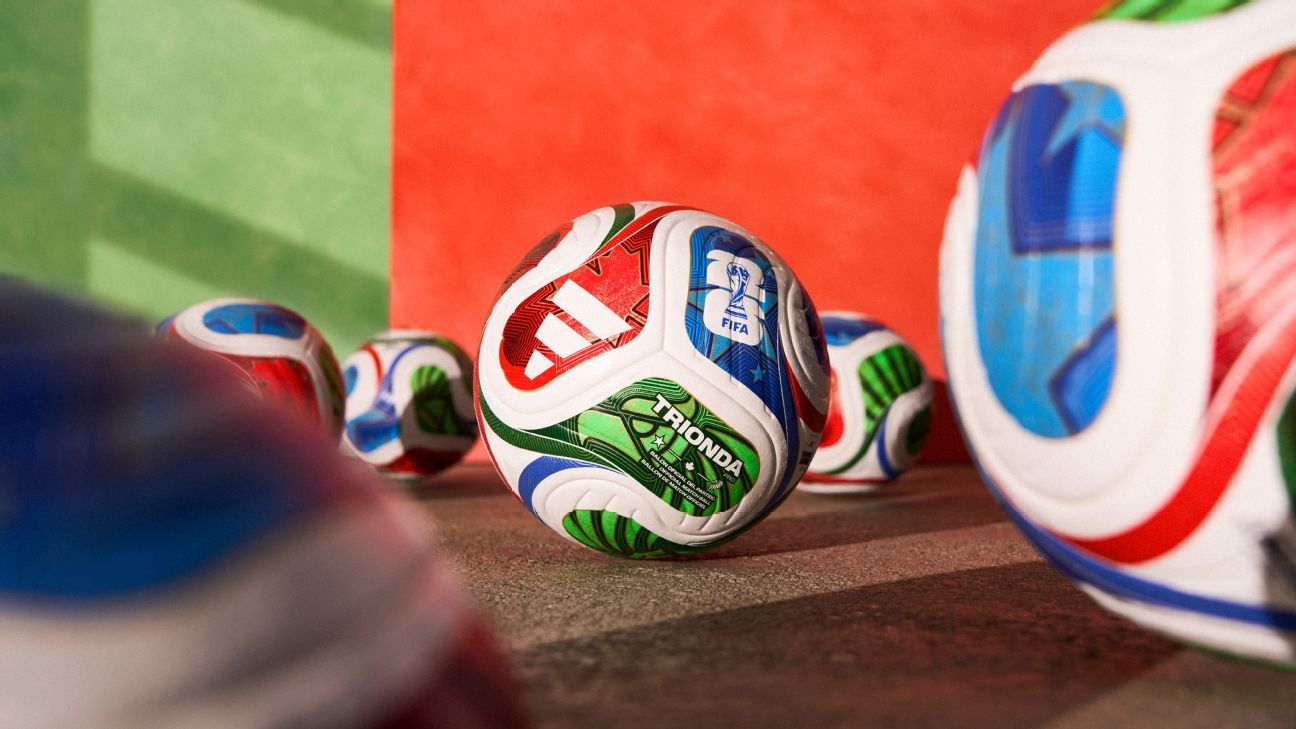
The 2026 FIFA World Cup kicks off next summer, and the world has got its first look at the official match ball that will be used at the tournament in Canada, Mexico and the United States.
Adidas has unveiled the Trionda, the 15th consecutive match ball supplied for a FIFA World Cup by the manufacturer in a relationship that dates back more than 50 years.
In all, there have been 23 different ball designs used since the first World Cup took place in Uruguay in 1930, with the Adidas era only beginning with the introduction of the classic Telstar ball at the 1970 World Cup in Mexico.
– Can anyone stop Yamal and Spain marching to World Cup glory?
– Ranking every World Cup mascot: From Ciao to World Cup Willie
– World Cup 2026 host cities: What you need to know about the 16 venues
Since the first World Cup was held in 1930, the changing materials and designs used for soccer balls is a way of charting the evolution of the game itself over the past century, from a more unsophisticated era to the ultramodern professionalism of today.
We take a look at the balls used at every World Cup, from the first one staged in Uruguay almost 100 years ago to the one that will be used when the latest edition kicks off next June.
Editors’ note: This article has been updated since it was first published in 2022.
1930: Uruguay (Tiento and T-Model)
There was no official ball produced for the first World Cup, with a number of different designs used throughout the tournament in Uruguay. Unusually, the final between the hosts and rivals Argentina began with a squabble over which country would provide the match ball, leading to a compromise that saw the first half played with Argentina’s model of choice (the Tiento) before being swapped out for the Uruguayans’ preferred ball (the T-Model) at half-time. Argentina were 2-1 up at the interval before Uruguay scored three goals with their larger, heavier ball in the second half to win 4-2 and take their place as inaugural champions of the world. Make of that what you will.
1934: Italy (Federale 102)
Manufactured by ECAS (Ente Centrale Approvvigionamento Sportivi, the Italian government’s central body for sport supplies) in Rome, the Federale was perhaps most notable for being the first World Cup ball to replace thick hardened-leather laces for cotton ones. As well as improving the binding between panels, using softer laces to stitch the ball together made heading the Federale less of a headache, if you’ll excuse the pun. Pictured holding the ball here is former Czechoslovakia captain Frantisek Planicka, who led his nation to the final where they lost 2-1 to the hosts.
1938: France (Allen Coupe du Monde Officiel)
Produced by the Allen factory in Paris, the Coupe du Monde ball was similar in appearance to the Federale with its 13-panel construction, cotton laces and dark brown cowhide outer shell. However, the edges of the Allen’s individual panels were much more rounded than the 1934 ball which made it rounder and more predictable. It also had to be hand-stitched and hand-inflated by a skilled worker to achieve a spherical finish.
1950: Brazil (Superball Duplo T)
Thanks to the technical advances made during the 12-year gap between tournaments due to World War II, the World Cup in 1950 witnessed a minor revolution in the design and manufacture of the official match ball. Gone were the panels and laces of yesteryear and in came the Duplo T, which featured a moulded rubber valve through which the enclosed internal bladder could be inflated by a simple hand pump, much like all modern-day footballs. The concept had already been in use in Argentinian football for many years beforehand but the syringe valve design wasn’t cleared by FIFA for use at World Cups until 1950.
1954: Switzerland (Kost Sport Swiss World Champion)
The Swiss World Champion was the first 18-panel leather ball used at a major football tournament, with a more daring yellow colour and interlocking “W” panels lending the ball a modernised look.
1958: Sweden (Top Star)
Made by Swedish company Sydlader AB, which was founded in 1914 and initially produced leather drive belts for industrial and agricultural machinery. Sydlader was appointed as official ball suppliers for the ’58 World Cup after the Top Star was chosen in a blind test of over 100 designs by a panel of FIFA officials. Each team was then provided with 30 of the balls for use during the tournament. France forward Just Fontaine clearly liked it: He scored 13 goals in six matches in Sweden, a record for a single tournament which has never been bettered.
1962: Chile (Custodio Zamora Mr Crack)
With an 18-panel design inspired by a volleyball, the Crack was a chrome coloured ball that had a smoother, rounder surface (and hence better, more uniform behaviour) than any other World Cup match ball. It was also the last World Cup ball to be provided by a locally tendered company, with Senor Custodio Zamora of San Miguel charged with producing it especially for the tournament. Unfortunately, due to issues with abrasion, brittleness and waterlogging, the Crack was dismissed as inadequate by players and officials alike, leading to a variety of hastily sourced alternatives being used throughout the tournament instead.
1966: England (Slazenger Challenge 4 Star)
After the Crack proved to be anything but, FIFA decided that they would eschew local manufacturers and instead entrust the supply of World Cup match balls to established multinational sports companies. The first such offering was the Slazenger Challenge 4 Star, a 25-panel ball with a latex valve produced in white, bright orange and yellow and selected before the tournament by the English FA in another blind test. The orange variant was chosen for the final as England beat West Germany 4-2 in extra time to lift the Jules Rimet trophy at Wembley. Here, former U.K. Prime Minister Gordon Brown (right) holds the 1966 ball as ex-FIFA president Sepp Blatter marvels at the 1930 version.
1970: Mexico (Adidas Telstar)
The Adidas era began in 1970 with the introduction of the original Telstar, a 32-panel “truncated icosahedron” design that came to define what a typical football would look like for decades to come. Named after a similarly spherical U.S. satellite, a total of 20 Telstars were supplied by Adidas for use at the tournament, meaning they weren’t used in every game, with miscellaneous unmarked brown and white balls used at some matches as well. The distinct two-tone design of the Telstar also made the ball easier to follow for people watching matches at home on black-and-white televisions, though an all-white “Chile Durlast” variation was also used in some games.
1974: West Germany (Adidas Telstar Durlast)
Fundamentally the same design as the original Telstar, the Durlast featured a new, thin polyurethane coating over the leather panels that improved its resistance against waterlogging and abrasion. The tournament was a home triumph both for Adidas and the West Germany team, which lifted the trophy after beating Johan Cruyff’s Netherlands in the final.
1978: Argentina (Adidas Tango)
One of the most iconic soccer balls of all time, the Tango was introduced for the 1978 World Cup and lasted for many years with only a few minor alternations made to the design. The ’78 Tango consisted of 20 hexagonal handstitched panels coated in a thin plastic “Durlast” membrane to help guard against waterlogging. The graphic design also used triangular markings on each panel to create the illusion of white circles all over the surface, which helped players track the spin of the ball through the air more easily.
1982: Spain (Adidas Tango España)
So widely popular was the Tango design that it lasted Adidas from 1978, through the 1982 World Cup in Spain and on to the European Championships and Olympic Games of 1988. The ’82 España edition received only very minor cosmetic updates, though the seams were rubberised to improve its water resistance. The España is also notable for being the last fully leather ball to be used at a World Cup tournament before the dawn of the synthetic era.
1986: Mexico (Adidas Azteca)
While the Tango was still in use, Adidas decided that a brand new ball was required for the 1986 World Cup and hence the Azteca was created. While resembling the Tango with its hand-sewn 32-panel design, the Azteca was manufactured using 100% synthetic materials and the triangular designs on the panels featured elaborate detailing inspired by Aztec frescoes and culture. It also holds a unique place in football history by being the ball that Argentina’s Diego Maradona punched over the head of England goalkeeper Peter Shilton for his infamous “Hand of God” photo en route to winning the tournament.
1990: Italy (Adidas Etrusco Unico)
Much like the Azteca before it, the Etrusco Unico drew inspiration for its design by the ancient culture of the World Cup host nation. Rather than Aztec art, the 20 triangular triads on the Unico ball were gilded with a depiction of the lions heads regularly found in countless works of Etruscan sculpture, jewellery, fine art and architecture. The Etrusco Unico was also the first World Cup ball to feature an internal layer of black polyurethane foam beneath the outer shell to help provide further protection against waterlogging and to improve the durability and rebound quality.
Although its name conjured images of man’s ancient quest to reach the stars and the 25th anniversary of the Apollo 11 moon landing, the Questra was in essence the latest in a succession of Tango clones. Visually very similar to the three World Cup match balls that preceded it, the Questra featured the same pentagonal panel design used on the Azteca and Estruco Unico, though the flourishes in the detailing this time reflected the wonders of space exploration. The Questra was also much lighter than previous World Cup balls, leading attacking players to commend its ability to swerve and curl and goalkeepers to bemoan its unpredictability in the air.
1998: France (Adidas Tricolore)
Fittingly, the Tricolore was the first multicoloured ball to be used at a World Cup, with the traditional monochrome palette updated to reflect the traditional colours of the host nation: red, white and blue. While the fundamental design of the ball remained unchanged, the cockerel and the flag were selected as the traditional symbols of France to be incorporated into the triad motif. The Tricolore was also the last World Cup match ball to bear the now-iconic “Tango” aesthetic as Adidas began to experiment with new manufacturing techniques and altogether more daring colourways.
The Fevernova saw Adidas break away from the traditional Tango design in favour of a radical offset graphic inspired by Asian culture, which consisted of a three-pronged golden shape (inspired by a Japanese “tomoe” symbol) and red streaks meant to resemble the ancient art of calligraphy. Despite being constructed using 11 different layers, the ball was widely criticised for being far too light and unpredictable, largely as a result of the airy synthetic foam used as padding inside the rubbery polyurethane exterior.
2006: Germany (Adidas Teamgeist and Teamgeist Berlin)
The 2006 World Cup in Germany was the first tournament that saw a second, alternative design of the official match ball produced especially for use during the latter stages of the competition. The standard Teamgeist (meaning “team spirit”) was white with black oval-shaped banding and constructed using just 14 thermally bonded synthetic panels to create a rounder, more precise and almost entirely waterproof ball. A special golden version was produced for the final in Berlin. However, due to having fewer seams, air resistance was reduced to the point that several prominent players complained about the ball’s movement in the air, something which was fast becoming a pre-tournament tradition.
2010: South Africa (Adidas Jabulani and Jo’bulani)
Largely remembered as one of the most troublesome World Cup match balls of all time, the Jabulani had a lively name (translating from the Zulu phrase meaning “be happy”) and an even livelier tendency to dip, swerve and balloon away into the terraces. Made from eight moulded panels, the surface of the Jabulani was also textured with thin ridges and grooves in an effort to improve aerodynamics. However, after the opening bouts of the competition were blighted with handling errors several goalkeepers including Gianluigi Buffon and Julio Cesar went public with their concerns over the unpredictability of the ball. As in 2006, a special gold-tinted version of the Jabulani was introduced for the final staged in Johannesburg, hence the name.
2014: Brazil (Adidas Brazuca and Brazuca Rio)
The first World Cup ball to be named by public vote, the Brazuca was made from six bonded polyurethane panels and decked out in a vivid graphic inspired by Bahia bands — traditional Brazilian good luck bracelets made from colourful yarn. With the Jabulani deemed something of a failure, the emphasis was on creating an aerodynamically stable ball that performed consistently in all conditions. Thankfully, the Brazuca was able to avoid the pitfalls of its direct predecessor after undergoing two years of rigorous testing prior to the tournament. Once again, a special version was produced for the grand final in Rio de Janeiro with the green, red and blue flashes of the standard Brazuca replaced by green, gold and black.
2018: Russia (Adidas Telstar 18 and Telstar 18 Mechta)
Harking back to the glory days of the early 1970s, Adidas updated their classic Telstar design for use in Russia. Rather than using 32 handstitched panels, the modernised Telstar was constructed from just six panels thermally bonded to create a rounder, smoother, more consistent surface. However things got off to an ominous start when two balls burst during a group-stage game between France and Australia. As has become tradition, an alternative design was rolled out for the knockout phase, with the Telstar 18 Mechta (“mechta” being a Russian word for ambition) being unveiled. The only real difference being the red speckles on the shell.
2022: Qatar (Adidas Al Rihla)
The Al Rihla (a name that translates from Arabic into English as “the journey”) was a 20-panel design that Adidas said was inspired by the architecture, art and national flag of Qatar. In order to reduce air resistance at what proved to be one of the hottest World Cup finals ever, the ball was made to appear completely seamless and the shape of the thermally bonded panels were directly inspired by the sails of the famous Dhow boats that are emblematic of the Gulf state.
2026: United States, Mexico and Canada(Adidas Trionda)
The Trionda features a swirled graphic that mixes red, green and blue — a tricolor designed to represent the national colors of all three of the host countries. The red panels feature the Canadian maple leaf, the blue panels are spangled with stars, and the green swathes have a graphic inspired by the symbolic Aztec eagle.
The detailing is then added in gold, which serves as a visual reference to the World Cup trophy itself. Furthermore, the name is a nod to the 2026 tournament’s triumvirate of North and Central American hosts, with “Tri” obviously meaning “three” and “Onda” meaning “wave” in both Spanish and Portuguese.
The entire ball is made up of just four panels, with debossed lines and embossed country icons to create a surface which, according to the manufacturer, “produces optimal in-flight stability by ensuring there is sufficient and evenly distributed drag as it travels through the air.”
We’ll have to wait until next summer to find out exactly what that means for goalkeepers.
Sports
NHL Bubble Watch: Projecting playoff hopes for all 32 teams
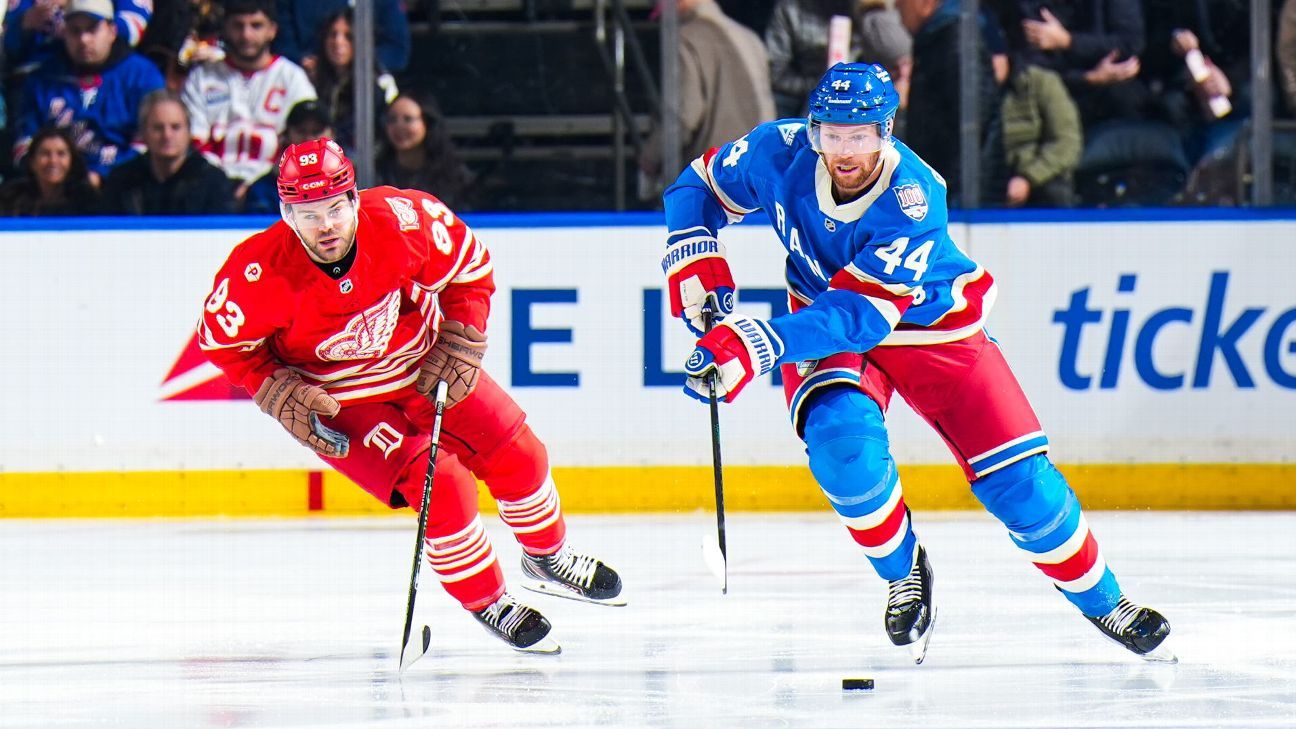
The NHL playoff bubble is pretty much the size of that one Glinda flies around in during “Wicked.”
Heading into Tuesday night, no team in the East was more than four points out of the wild-card spot. In the West, all but three teams were within three points of a playoff spot. If the NHL is striving for parity, this has been an ideal start.
The NHL Bubble Watch is our monthly check-in on the Stanley Cup playoff races using playoff probabilities and points projections from Stathletes for all 32 teams. We also reveal which teams shouldn’t worry about any of this because they’re lottery-bound already.
This month, we’re also looking at points of concern early this season for teams inside and outside the bubble.
But first, a look at the current playoff bracket:

Current playoff bracket
M1 Carolina Hurricanes vs. WC2 Tampa Bay Lightning
M2 New Jersey Devils vs. M3 Pittsburgh Penguins
A1 Detroit Red Wings vs. WC1 New York Islanders
A2 Boston Bruins vs. A3 Montreal Canadiens
C1 Colorado Avalanche vs. WC2 Seattle Kraken
C2 Dallas Stars vs. C3 Winnipeg Jets
P1 Anaheim Ducks vs. WC1 Chicago Blackhawks
P2 Vegas Golden Knights vs. P3 Los Angeles Kings

ATLANTIC DIVISION
The locks

Record: 10-7-2, 22 points
Playoff chances: 95.1%
The Stathletes model still loves the Lightning despite an inconsistent start. A lot of that can be chalked up to a torrent of injuries to players such as forwards Anthony Cirelli and Nick Paul, and defensemen Victor Hedman and Ryan McDonagh. Less understandable has been star center Brayden Point‘s inability to hit the score sheet with his typical consistency during his first 18 games of the season.
All of these factors have contributed to the Lightning’s power play sputtering to 29th in the NHL this season, which is a huge reason their offense ranked 17th after 18 games. Since 2022, Tampa Bay’s power play (26.6%) was second only to Connor McDavid and the Oilers (27.8%) in conversion rate.
There’s a reason the Lightning were a popular pick to win the Atlantic, and Stathletes still has them projected for 103 points this season. They can be an elite team when healthy and playing to their full potential.
Cause for concern: After the Vancouver Canucks rallied with six straight goals to beat the Lightning in Tampa last weekend, coach Jon Cooper lamented that his team clearly rested on its early lead, comparing the matchup to “the tortoise and the hare.” There have been a few too many instances where the Lightning haven’t kept their foot on the gas.
Yes, it’s early. Yes, a healthy veteran lineup should correct that. But you want to see the killer instinct of a team like Colorado when it comes to what many believe could be the beast of the East this season. And the Lightning haven’t necessarily found that yet.
Work to do
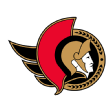
Record: 9-6-4, 22 points
Playoff chances: 60.4%
The Senators got three games out of Brady Tkachuk before their captain was sidelined with a thumb injury, having last played on Oct. 13. Ottawa has gone 8-4-4 in his absence, which is admirable considering how much Tkachuk is the team’s engine. Balance has been the name of the game.
Ottawa is still giving up more goals on average than it’s scoring, but it is finding ways to win games. Tim Stutzle (10 goals in 19 games) has been great, as have Drake Batherson (18 points in 16 games) and Shane Pinto, who earned a new contract with a strong offensive start. The Senators have eight different players in double digits in points through 19 games and have gotten goals from 17 different players.
Analytically, they’re outscoring their expected goals at 5-on-5. The trouble is, they’re worse defensively than their expected goals against per 60 minutes, which ranks second in the league. That’s because …
Cause for concern: … their goaltending has been a horror show. Through 19 games, both Linus Ullmark (minus-8 goals saved above expected) and Leevi Merilainen (minus-2.6) are underwater analytically, and their traditional stats aren’t any better, as both netminders had save percentages under .875.
Ullmark has played slightly better recently, but things with rookie Merilainen were so bumpy that he was demoted to the AHL for a bit to locate his game.

Record: 10-8-1, 21 points
Playoff chances: 47.7%
The Panthers had one prime directive to start the season: Tread water until the reinforcements arrive.
Florida knows it’ll get Matthew Tkachuk back in either December or January after he underwent surgery on his groin. Maybe forwards Tomas Nosek and Jonah Gadjovich and defenseman Dmitry Kulikov will return later in the season. Perhaps the Panthers’ prayers are answered and star captain Aleksander Barkov comes back to the lineup after a freak preseason injury that required surgery to repair the ACL and MCL in his right knee.
Whatever happens, Florida’s hopes for a dynastic Stanley Cup three-peat — the first one since the New York Islanders won four straight Cups in the 1980s — rest on the Panthers not digging an early-season hole in the standings. They’ve successfully avoided that through 19 games, earning a .553 points percentage.
The Panthers’ MVP this season has easily been the Rat King himself, Brad Marchand. The 37-year-old had 23 points in his first 18 games, including a team-leading 13 goals. His partnership with center Anton Lundell saw them go from an essential checking line during last season’s Cup run to the team’s top scoring line in Tkachuk’s absence.
Cause for concern: There’s a reason no one has captured three Stanley Cups in three straight seasons since the days of Mike Bossy and Denis Potvin. There are a lot of miles on some of these Panthers’ tires, especially when you consider they also made a run to the Stanley Cup Final before their back-to-back Cups. There’s already been a wave of injuries this season.
If Florida makes the postseason cut, it’s foolish to believe it couldn’t pull off the three-peat, because this team seems to have been designed in a lab to win in the playoffs. But it’ll be four years of this grind, and that’s a lot of grinding.
0:26
Brad Marchand tallies goal vs. Canucks
Brad Marchand tallies goal vs. Canucks

Record: 10-6-3, 23 points
Playoff chances: 47.3%
After a surprising return to the Stanley Cup playoffs last season, the Canadiens picked up where they left off with a potent offense (sixth in scoring through 18 games) overcoming a somewhat porous defense (25th). Their top line of Cole Caufield, Nick Suzuki and Juraj Slafkovsky is among the best in the NHL, with Suzuki (21 points in 18 games) and Caufield (13 goals) both making early declarative statements to make their respective Olympic teams.
The next wave of Canadiens has made an impact, too. Defenseman Lane Hutson built on his Calder Trophy win with 14 points in 18 games. Winger Ivan Demidov, this season’s Calder favorite, has started strong.
Perhaps most importantly, rookie goalie Jakub Dobes has been outstanding as veteran netminder Sam Montembeault has struggled mightily out of the gate.
Cause for concern: Injuries, injuries and more injuries. Center Kirby Dach will miss the next four to six weeks with a fractured foot. Defenseman Kaiden Guhle could miss up to 10 weeks after undergoing an adductor muscle surgery. Forward Alex Newhook will miss the next four months because of a broken ankle.
The trio joined an injury list that already included scoring winger Patrik Laine, who will miss at least three months after core muscle surgery.

Record: 12-7-1, 25 points
Playoff chances: 34.9%
For years, the debate around Dylan Larkin has been whether he was a true No. 1 center. After an eye-opening performance at the 4 Nations Face-Off last season, Larkin has answered that question with a brilliant first 19 games of the season, with 11 goals and 12 assists as the Red Wings’ early-season MVP.
The Red Wings’ offense should be better than their production. They’re ninth in expected goals per 60 minutes at 5-on-5 but rank 26th in goals scored. Getting Patrick Kane back from injury has helped, but Detroit needs to find a little more help beyond its consistent offensive options such as Alex DeBrincat and Lucas Raymond.
Cause for concern: Wait, wasn’t John Gibson supposed to be the answer in goal when GM Steve Yzerman acquired him from Anaheim? Gibson has been outplayed by incumbent Cam Talbot this season, sporting a .875 save percentage in 11 starts and playing to slightly below replacement levels.
Long shots at best

Record: 9-9-2, 20 points
Playoff chances: 24.9%
Life without Mitch Marner has proved difficult for this Maple Leafs team, which had a .474 points percentage entering Tuesday night’s games, tied for last in the conference. Marner is not irreplaceable, but there was zero chance this season’s Maple Leafs were going to sufficiently replace his regular-season contributions on both ends of the ice.
They can still score, as their goals per game through 19 games was higher than last season’s average. William Nylander has been brilliant again, with 26 points in 16 games. John Tavares has 11 goals in 19 games. But a team that finished eighth in the NHL in goals against per game last season under Craig Berube ranks 31st this season. Injuries to forward Scott Laughton, defenseman Chris Tanev and goalie Joseph Woll have contributed to that. Also not helping matters is goalie Anthony Stolarz being unable to find a groove, playing well below replacement level with an .884 save percentage.
The critics are out for the Leafs already in Toronto, with some questioning if this roster is playoff-worthy. The heat on Berube was turned up so high that GM Brad Treliving had to give a vote of confidence. (Uh-oh.) This is what happens when the Blue Jays’ playoff run ends.
Cause for concern: Easily the biggest cause for concern is Auston Matthews. The star center had nine goals and five assists in 17 games before leaving the lineup with a lower-body injury. The Leafs experienced life with a diminished Matthews last season, when he scored 33 goals in 67 games after scoring 69 goals in 81 games in 2023-24. If Toronto is going to rally for a playoff berth, it needs its MVP in the lineup and playing like one.

Record: 7-8-4, 18 points
Playoff chances: 11.2%
The Sabres are seeking their first playoff berth since 2011, and it was starting to look like that streak would remain very much intact. But a couple of wins over the Red Wings and the Edmonton Oilers have Buffalo trending in the right direction again.
Tage Thompson has been on a scoring heater. Rasmus Dahlin returned to the team after tending to a personal matter. Some of the young players in the supporting cast have started to contribute more.
Offensively, the Sabres are just outside the top 10 in expected goals per 60 minutes at 5-on-5, but they have some work to do in puck possession, ranking around 25th in percentage of shot attempts.
Cause for concern: The Sabres are tap-dancing on a land mine when it comes to their goaltending, behind a defense that still yields too much at even strength. Can Alex Lyon be counted on throughout this season? Is Ukko-Pekka Luukkonen part of the solution or potential trade bait? And what to make of rookie Colten Ellis, whose starts have either been Calder-worthy or cringe? (And whither Devon Levi?)

Record: 12-9-0, 24 points
Playoff chances: 3.2%
Again, it must be stressed that this is what the Stathletes model currently projects as the Bruins’ playoff chances, despite this team being in second place in its division after Tuesday’s games.
New coach Marco Sturm played five seasons with the Bruins, three of them in the defensive system of Claude Julien. He was inspired by Julien’s layers of defensive zone coverage, adopting that system for himself. But Sturm tweaked that philosophy to include man-on-man defense to better pressure puck carriers. So far, the results are … well, it’s a work in progress. The Bruins are 26th in the NHL in expected goals against, and they’re 27th in shot attempts against per 60 minutes at 5-on-5.
Luckily, a full training camp did goaltender Jeremy Swayman some good. Through 12 games, he had over nine goals saved above average and eight wins. Offensively, the Bruins have been one of the surprises of the league, with 3.35 goals per game through 20 games. Although 18 different players have a goal this season, it’s been the Morgan Geekie and David Pastrnak show. Geekie proved wrong his doubters who thought that last season was a fluke, scoring 12 goals in 21 games. Pasta continues to be one of hockey’s elite scorers with 11 goals. Combined, they have 44 points on the season.
Cause for concern: Can two players carry an entire offense? Geekie and Pastrnak are the only players to score more than six goals through 21 games this season. It’s never a good sign when a team’s offense can be better defined as a “duo.”

METROPOLITAN DIVISION
The locks

Record: 13-5-1, 27 points
Playoff chances: 99.6%
The Hurricanes don’t have an offensive superstar like Mikko Rantanen, but they might have the best offensive depth that they’ve had under head coach Rod Brind’amour. Carolina was averaging 3.62 goals per game through 19 games, led by Seth Jarvis (10 goals) and Sebastian Aho (18 points) but buoyed by Taylor Hall, Logan Stankoven and Nikolaj Ehlers, all players who arrived in Raleigh in the past calendar year. Second-year man Jackson Blake has also taken a significant leap in production.
Meanwhile, they’re still playing Brind’Amour-quality defense despite star blueliner Jaccob Slavin having been limited to just two games because of injuries, and K’Andre Miller missing a half-dozen games as well.
Cause for concern: Will that offensive depth eventually be enough to break through the Eastern Conference into the Stanley Cup Final, or will we continue to have those “what if” conversations about another Brind’Amour team that couldn’t produce a key goal at a key time in the postseason?

Record: 9-8-2, 20 points
Playoff chances: 90.4%
The Stathletes model likes the Capitals quite a bit.
If this is Alex Ovechkin‘s final season — and despite a disturbing amount of jersey swaps with other NHL stars, that hasn’t been decided yet — coach Spencer Carbery’s team seems determined to make it another playoff year for its captain.
The Capitals continue to chug along with a combination of dependable veterans, energizing young players and solid team defense in front of outstanding goaltending. Ovechkin scored goal No. 900 and is starting to heat up. Their leading scorer has been Tom Wilson (nine goals, nine assists), who is down bad to earn a Canadian Olympic team spot.
But their MVP has been goalie Logan Thompson, who might not have the same stunning won-loss record as last season but has better overall numbers in this campaign.
Cause for concern: Despite having Ovechkin blasting pucks from his office, the Capitals’ power play has been a point of concern for Carbery for the past two seasons. It ranked 30th in the league through 19 games this season, and it’s missing the injured Pierre-Luc Dubois, who was tied for fifth on the team in power-play points last season.
Work to do

Record: 10-9-2, 22 points
Playoff chances: 87.8%
The Stathletes model loves the Rangers’ playoff chances despite an unbalanced start to their season. And by “unbalanced” we’re of course referring to the fact that they were 1-7-1 at home and 9-1-1 on the road in their first 20 games, which is a heck of a thing.
It took a minute for the scoring stats of some of the Rangers’ top players to catch up to their analytics. Players such as Alexis Lafreniere, Artemi Panarin and Will Cuylle are starting to hit their marks, with Cuylle beginning to look more like the Chris Kreider replacement he was billed to become. Perhaps he can help jump-start J.T. Miller, whose seven even-strength points in his first 20 games is one of the season’s most curious numbers.
The good news as always for the Rangers: The goaltending of Igor Shesterkin and Jonathan Quick can paper over a lot of deficiencies on this team.
Cause for concern: It remains the Rangers’ depth, which really gets exposed when the big dogs aren’t barking. They are a team with solid top-six forwards, a fantastic top defensive paring of Adam Fox (quieting critics) and Vladislav Gavrikov (worth the investment) and then not enough behind them — at least not yet — to make this group a real contender for the Cup, even if its regular-season prospects are solid.

Record: 11-7-2, 24 points
Playoff chances: 56.6%
With Matthew Schaefer, all things are possible. The 18-year-old first pick was like a shot of adrenaline to the heart of this franchise, both in his charismatic personality and his stellar play by any standard, let alone a rookie’s. Schaefer had 15 points in 19 games to start his NHL career, second on the Islanders. His skating and offense have earned him early comparisons to Cale Makar. He has been that good.
Schaefer has grabbed the headlines, but the Islanders have had a handful of strong starts to put them in the playoff conversation, including Bo Horvat (12 goals in 19 games), Mathew Barzal (15 points in 18 games) and especially Emil Heineman (nine goals), who arrived from Montreal in the Noah Dobson trade.
Cause for concern: Ilya Sorokin has 8.8 goals saved above expected in 13 games because the Islanders’ 5-on-5 defense in front of him has been leaky — 29th in the NHL in expected goals against per 60 minutes, and generating only 48.5% of the shot attempts. They must turn those underlying numbers around to contend in the East.
0:56
Matthew Schaefer makes NHL history with OT winner for Islanders
Matthew Schaefer becomes the youngest player in NHL history to score an overtime goal in the regular season.

Record: 10-8-2, 22 points
Playoff chances: 50.1%
There are so many things about the Blue Jackets that one loves to see so far this season.
Winger Kirill Marchenko‘s star keeps rising with 22 points in 19 games. Ditto forwards Dmitri Voronkov (16 points) and Adam Fantilli (13 points). Defenseman Zach Werenski, Norris Trophy runner-up last season, is off to another strong start. Young goalie Jet Greaves could be the solution in net they’ve been waiting for.
Cause for concern: But what do these parts add up to? The Jackets still have trouble defending, with their surprisingly stout goaltending overcoming some wonky D-zone metrics. Their special teams, in particular their penalty kill (26th), are in the bottom third of the league.
Again, there are a lot of things to like about Columbus and it’s an easy team to root for. But does coach Dean Evason have a playoff team on his hands or one that’ll just hang around the bubble?

Record: 10-5-4, 24 points
Playoff chances: 41.8%
The Penguins’ 10-5-4 start has them in a playoff spot 19 games into the season, which has significantly reduced the speculation about the futures of Sidney Crosby and Evgeni Malkin. They want to play in the playoffs. If the Penguins are good enough to offer them a legitimate chance of doing so, they’re likely not leaving Pittsburgh this season.
Of course, they’re also the primary reason the Penguins are pushing for the postseason. Malkin, in a contract year, had 23 points through 19 games. Crosby led the team, and nearly the league, with 12 goals. Through a variety of linemates and lineups, the Penguins’ two franchise icons are willing this team to relevance.
Cause for concern: Is this real? Crosby had openly talked about how the Penguins didn’t rebuild on the fly the way the Capitals did around Ovechkin. So far, Pittsburgh’s young supporting cast has provided enough around the veteran core to make things work under new coach Dan Muse.
But the Penguins are getting better defensive results than their metrics would predict, thanks to the second-best team save percentage in the NHL (.915). To which we ask again: Is this real?

Record: 9-6-3, 21 points
Playoff chances: 27.2%
In some ways, the Flyers are a very similar team to the one that predated new coach Rick Tocchet’s arrival. They don’t earn the majority of shot attempts. They are fairly good defensively at 5-on-5, although with a propensity to get stuck in their own zone a bit too much. Luckily, goalie Dan Vladar (.909 save percentage in 11 games) has been one of the offseason’s best pickups, giving the Flyers saves they weren’t getting last season.
Where Tocchet has made an impact is in giving this retooling team some structure, which helps in suppressing shots but at the sacrifice of some offense. It’s a tough team to play against, but perhaps not a dangerous enough one.
Cause for concern: The Flyers’ best offensive player this season is a flashy trick-shot artist with a dynamic offensive game. That this player is Trevor Zegras — scoring more than a point per game — and not Matvei Michkov is a bit of a surprise. But it’s been bumpy ride for Michkov in his second season, with inconsistent play and fluctuating ice time that included being benched by Tocchet. That tough love is designed to make him a better player. But in the short term, the Flyers need the kind of production Michkov had last season.
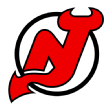
Record: 13-5-1, 27 points
Playoff chances: 21.8%
I was sort of baffled by the playoff probability here, as the Devils are tied atop the Metro Division, but had playoff odds in the neighborhood of the St. Louis Blues and Red Wings.
The way the Stathletes’ model works, the probability is based on the current lineup for the full season. Which means a Devils team without Jack Hughes, who needed surgery on his hand after a “freak accident” at a recent team dinner. In reality, if Hughes is out for eight weeks, that means he’d miss around 50% of their remaining games. The probability then would be more in the neighborhood of 45% rather than this dire prediction.
The Devils are going to miss Hughes greatly, considering what an incredible start he had. Regrettably but understandably, they have learned to play without him, as they did last season when Hughes missed the last month and a half while the Devils scratched and clawed to make the playoff cut. That’s especially true of winger Jesper Bratt, who had 16 points in the 13 games after Hughes was injured last season.
Cause for concern: One way to get through the Jack-less part of the schedule would be for the Devils to rely on their goaltending. But Jacob Markstrom remains a goaltender who can’t be trusted. He has an .870 save percentage in eight starts, with a minus-2.1 goals saved above expected. He has been outplayed by crease-mate Jake Allen. Markstrom has a higher ceiling and could carry this team if he gets hot. But the Devils will settle for him to be consistent enough to make this tandem something better than 11th in team save percentage.

CENTRAL DIVISION
The locks

Record: 13-1-5, 31 points
Playoff chances: 99.9%
Just 19 games into the season, there is a 0.01% chance the Avalanche don’t make the playoffs. They’ll probably take those odds.
The Avs have one regulation loss in their first 19 games. ONE! The Bruins beat them 3-2 on Oct. 25 thanks to 31 saves from Jeremy Swayman. Otherwise, it’s been all victories and post-regulation losses for the Central Division leaders.
Entering Tuesday night, Colorado led the league in goals scored (4.11 per game, the only NHL team scoring four or more on average) and goals-against average (2.37 per game). Nathan MacKinnon led the league in goals (14) and points (33) and plus-minus (plus-19). Cale Makar led all defensemen in points (25). Sixteen different Avs had scored at least a goal this season.
Meanwhile, journeyman goalie Scott Wedgewood was a revelation through 15 games, going 11-1-2 while Mackenzie Blackwood worked his way back from injury.
Colorado is the NHL’s best team about a quarter way through the season, and there’s still room for improvement.
Cause for concern: Let’s assume that the team’s power play (16.7%) eventually finds its groove and focus on two players who haven’t sprinted out of the gate for Colorado. Brock Nelson, who signed a new deal with the Avalanche after they acquired him from the Islanders at the trade deadline last season, has nine points in 19 games. Captain Gabriel Landeskog remains of the NHL’s greatest feel-good stories, but he has just six points in 21 games while skating 13:41 on average.

Record: 12-5-3, 27 points
Playoff chances: 87.4%
When it comes to the Stars, it’s been interesting to see what hasn’t gotten the full attention of the NHL. Like the fact that Mikko Rantanen, whose status as a superstar player was debated during his dual trades last season, had 26 points in 19 games, good for sixth in the NHL in points-per-game average (1.37). Or that Jason Robertson, mentioned more in trade rumors than anywhere else last season, has 23 points for the Stars. Or that Wyatt Johnston, last seen not scoring in the playoffs, leads the team with 11 goals.
Under new head coach Glen Gulutzan, the Stars are in the top 10 in both offense and defense, with both Jake Oettinger and Casey DeSmith playing well in goal. They’ve overcome some injuries and rougher starts for players to become entrenched in second place in the Central.
Cause for concern: The Stars’ defensive depth wasn’t all that deep to begin with before losing standout Thomas Harley, who is week-to-week with a lower-body injury. With Nils Lundkvist also on long-term injured reserve, that lack of depth is being tested early for Dallas. When Harley does return, the Stars hope it’s with a better run of play than his first 18 games, in which he scored one goal and skated to a minus-7.
Work to do

Record: 9-7-4, 22 points
Playoff chances: 82.7%
Whether Kirill Kaprizov is worth $17 million against the salary cap annually remains a debate worth having, especially when one considers the contracts signed in the aftermath of that megadeal. What can’t be disputed is his offensive acumen and how vital it is to the Wild. Kaprizov led the team with 23 points, including 11 goals, in their first 20 games of the season.
Matt Boldy (21 points, including 10 goals) and his linemate Marcus Johansson (17 points) were the Wild’s other leading scorers. Rookie defenseman Zeev Buium (10 points) has helped juice their power play to fourth in the NHL.
One of the more intriguing developments for the Wild is the start for Jesper Wallstedt, the team’s perpetual “goalie of the future.” Perhaps the future is now: He won four of his first six starts with a stellar .924 save percentage and two shutouts. The Wild are the fifth-best team in 5-on-5 goals against per 60 minutes.
Cause for concern: Alas, they were 32nd in the NHL in goals per 60 minutes at 5-on-5 through 20 games (1.79). There’s a significant drop-off after those top three scorers. The Wild have dealt with some injuries up front, including one to center Marco Rossi that has him week-to-week. That obviously has played a role in this, but overall it’s been a sputtering offensive start for Minnesota.

Record: 10-7-3, 22 points
Playoff chances: 78.5%
The Mammoth were picked by many to make the playoffs in their second season in Salt Lake City, and they’ve been in the playoff mix through 19 games. They’re getting offensive contributions from veterans such as Nick Schmaltz (22 points) and Clayton Keller (18 points) and their outstanding younger stars such as Logan Cooley and Dylan Guenther (both with 15 points). Forward JJ Peterka, acquired from Buffalo last offseason, has hit his marks as well (13 points).
Cause for concern: The Mammoth should be better defensively at 5-on-5 than they’ve been, based on the analytics. But Vitek Vanecek (.875) and Karel Vejmelka (.883) haven’t played up to expectations, with both in the negative in wins above replacement, per Evolving Hockey.

Record: 12-7-0, 24 points
Playoff chances: 74.9%
Once again, the Jets’ holy trinity of Mark Scheifele (24 points), Kyle Connor (10 goals) and Josh Morrissey (19 points) is the driving offensive force for Winnipeg. Along with Gabriel Vilardi (14 points) and Nino Niederreiter (11 points), they’re the only Jets to have double-digit points through 18 games.
Meanwhile, Connor Hellebuyck (.913 save percentage, 2.51 goals-against average) is pushing for a Vezina Trophy hat trick as the Jets’ last line of defense. His underlying numbers indicate he’s doing some heavy lifting: 12.5 goals saved above expected in 14 games.
Cause for concern: The reason Hellebuyck has had to be so good? The Jets have inexplicably been one of the worst 5-on-5 teams, ranking 30th in the NHL in expected goals for and against this season. That includes generating just 45% of the shot attempts at 5-on-5. Looking back at last season, this is all a bit stunning. Was Nikolaj Ehlers the secret sauce after all?
0:40
Gabriel Vilardi wins it for the Jets in a shootout
Gabriel Vilardi wins it for the Jets in a shootout
Long shots at best

Record: 6-9-5, 17 points
Playoff chances: 24.8%
Stathletes still gives the Blues a 1-in-4 chance of making the Stanley Cup playoffs, which is probably news to the St. Louis fans who are in a full-on panic about a team with a .421 points percentage after 19 games.
There isn’t much that’s working for the Blues right now. They were 25th in the NHL in goals per game and 32nd in goals against, with the league’s worst goaltending so far (.861 save percentage). No one on the roster averaged a point per game. No one had cracked double digits in goals. Things are … not good.
Cause for concern: The Blues are 13th in expected goals against this season, down from third in the NHL at 5-on-5 last season, but still the kind of thing you’d expect from a Jim Montgomery team. The problem, again, is Jordan Binnington (minus-8.4 goals saved above expected) and Joel Hofer (minus-3.7) have been the league’s worst goaltending tandem through a quarter of the season, subverting any positive momentum the Blues can generate defensively.
Lottery-bound

Record: 6-10-4, 16 points
Playoff chances: 3.0%
GM Barry Trotz recently said the Predators are in a “transitional phase.” That’s a polite way of saying that the team he built might have some uncomfortable conversations and difficult decisions ahead of it after Nashville’s second straight bad start.
The Predators had a .400 points percentage after 20 games this season. From losing defenseman Roman Josi to injury to another inexplicably putrid start for Steven Stamkos (four goals in 20 games), few things have trended in the right direction under head coach Andrew Brunette.
Cause for concern: At the start of the season, it looked like the old Juuse Saros was back as the 30-year-old goalie was seeking to rebound from his worst NHL season statistically. But after 16 games, Saros had a .892 save percentage and was on the wrong side of both goals saved above expected and wins above replacement. The safety net had frayed, again.

Record: 10-5-4, 24 points
Playoff chances: 0.5%
Whether or not the Blackhawks make the playoffs matters not. This season needed to show some proof of concept. After 18 games, they’ve watched Connor Bedard dominate to the tune of 26 points in 18 games, including 10 goals. (That’ll get Team Canada’s attention.)
They’ve also seen Frank Nazar (12 points in 16 games) show that he can be Bedard’s offensive complement. They’ve seen Spencer Knight, acquired from Florida in the Seth Jones trade, play like a potential franchise goaltender with a .924 save percentage in 13 games under new head coach Jeff Blashill.
Cause for concern: Sam Rinzel is 20 years old with less than 30 games of NHL experience, so “concern” is a relative term here. But the 6-4 rookie defenseman was expected to be a significant contributor offensively this season, including as a potential power-play quarterback. After 17 games, he had one goal and two assists, having been already pulled from the line for a mental reset. He’s a terrifically talented player. He’ll be fine. But this was a rough start.

PACIFIC DIVISION
The locks

Record: 9-4-6, 24 points
Playoff chances: 99.8%
The Stathletes model clearly believes that the Golden Knights are much better than their very average start to the season — or at least that when the smoke clears in the Pacific Division, they’ll be in a playoff spot.
There have certainly been times this season when the Golden Knights have looked formidable against good teams. The performances from stars Jack Eichel (24 points in 18 games) and Mitch Marner (20 points) have been as advertised, and Vegas has also gotten great starts from Pavel Dorofeyev (11 goals), Tomas Hertl (15 points) and Shea Theodore, who has played well as the new No. 1 defenseman after Alex Pietrangelo bowed out due to injury this season.
But given their recent stumbles and some lineup absences, there’s a sense that the best is yet to come for the Golden Knights.
Cause for concern: Injuries to key players is nothing new for Vegas, but that doesn’t make it any easier to play through these absences.
Mark Stone last played on Oct. 18 before leaving the lineup with a wrist injury. His absence impacts every facet of the Knights’ game. Ditto William Karlsson, who is week-to-week with a lower-body injury. Starting goalie Adin Hill hasn’t played since Oct. 20. Ask the Knights and they’ll tell you this is nothing new, and that teams play through injuries every season. But until they get these key performers back, it’s hard not to see Vegas as being stuck in neutral.
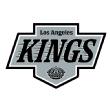
Record: 10-6-4, 24 points
Playoff chances: 83.4%
Anze Kopitar‘s decision to hang up the skates after this season lends some urgency — and perhaps a little melancholy — to the 2025-26 Kings campaign. GM Ken Holland certainly managed the roster with a win-now attitude, adding old Edmonton allies in winger Corey Perry (seven goals) and defenseman Cody Ceci.
But overall, this is much the same group that’s been unable to overcome the Oilers in the first round of the playoffs. Adrian Kempe (19 points in 20 games), Quinton Byfield (17 points) and Kevin Fiala (15 points) lead an offense for a team that basically gives up as much as it scores at 5-on-5, but one that ranks in the top six defensively at even strength.
Cause for concern: With 16 players age 29 or over on the roster, the ability for the Kings to stay healthy is paramount. They’re going to be without defenseman Drew Doughty for a couple of weeks due to a lower-body injury. Perry and Kopitar have both missed time this season. Their team defense and the goaltending of Darcy Kuemper should hopefully help them through injury absences, as they’re the reason L.A. has a .600 points percentage to start the season.
Work to do
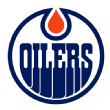
Record: 9-8-4, 22 points
Playoff chances: 75.9%
The Oilers and early-season panic over middling results … find a more perfect couple. Edmonton had a .524 points percentage through its first 21 games, leaving some to wonder if the Oilers would make the playoffs, let alone advance to a third straight Stanley Cup Final. Connor McDavid (30 points) and Leon Draisaitl (24 points) are dragging this group through that early-season malaise, with an assist by Jack Roslovic (seven goals), who has been a great addition to the roster.
It’s the same story as always for Edmonton, as Kris Knoblauch coaches through injuries and middling performances and mediocre goaltending to keep the Oilers close enough that Connor and Leon can carry them into the postseason. But how far can they go beyond that?
Cause for concern: Roslovic has been the exception to the rule for the Oilers, as many of their player additions in the past year haven’t made much of an impact. (Looking at you, Trent “one goal in 21 games” Frederic.) Young solutions on cheap contracts such as Matt Savoie and Isaac Howard weren’t ready to be the answer quite yet.
Overall, this roster seems diminished from previous editions, and not just because it lost the worm-like whimsy of Corey Perry. That’s not a great thing to have happen when the clock is ticking on McDavid’s time in Edmonton.

Record: 12-6-1, 25 points
Playoff chances: 68.1%
The arrival of coach Joel Quenneville and winger Chris Kreider helped supercharge the Ducks’ offense. They averaged 3.63 goals per game through 19 games, hanging a touchdown on a few opponents along the way.
Kreider had 10 goals in 15 games, with five of them coming on the power play. But the offensive parade in Disneyland was led by burgeoning young stars Leo Carlsson (26 points, including 11 goals) and Cutter Gauthier (22 points, including 12 goals) as well as Ducks mainstay Troy Terry (21 points). Anaheim is never out of a game thanks to that offense.
Cause for concern: Unfortunately, the game has another facet called “defense,” and Quenneville has some work to do there in order for the Ducks to be a real contender.
Entering Tuesday night, Anaheim was the second-worst team in expected goals against per 60 minutes at 5-on-5, and 25th in shot attempts surrendered. Lukas Dostal‘s Vezina Trophy-worthy goaltending has papered over much of this defensive deficiency, but that’s not a sustainable model for a playoff team in the West. The Ducks are young. They’ll improve. But they’re not there defensively yet.
Long shots at best

Record: 9-5-5, 23 points
Playoff chances: 9.9%
Lane Lambert’s arrival behind the Kraken bench has given the team better structure and more confidence early this season. The Kraken have cut down on the high-danger chances for opponents and have been near the top 10 in expected goals against. That has helped their goalies to seventh in the NHL in save percentage. When even Philipp Grubauer‘s stats look good, you know the defense is doing its job.
Seattle is getting enough offensive contributions from veteran scorers such as Jaden Schwartz (14 points) and Jordan Eberle (13 points) to sit second in the Pacific after 18 games, winning three games in overtime and picking up five charity points.
Cause for concern: As much as Lambert’s defensive structure has benefitted the Kraken, their offense hasn’t been nearly as effective. Seattle ranked last in expected goals for and 30th in goals per 60 minutes during this hot start.
Getting Jared McCann back from injury should help, as he was limited to just five games after topping 60 points in each of the past three seasons. But the Kraken need more offensive crackle to make the playoff cut.
Lottery-bound
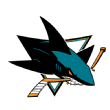
Record: 9-8-3, 21 points
Playoff chances: 5.7%
The Sharks were a surprising .500 team through the first 19 games of the season thanks to Macklin Celebrini playing like a Hart Trophy finalist. His 27 points in that span were 10 points better than teammate Will Smith to lead the Sharks, including 10 goals.
It’s a season so dominant that he might have played his way onto the Canadian Olympic team, and rightfully so.
Cause for concern: There should be some concern about the chiropractic health of Celebrini and the Sharks’ goaltenders, because they’ve carried the team on their backs so far this season. Yaroslav Askarov and Alex Nedeljkovic have San Jose just outside of the top 10 in team save percentage, with Askarov in particular playing better than expected.
The Sharks probably don’t have the depth to avoid the lottery again, but they’re fun and full of potential.
0:32
Macklin Celebrini’s hat trick wins it for Sharks in OT
Macklin Celebrini scores on the power play for San Jose Sharks

Record: 5-13-3, 13 points
Playoff chances: 5.0%
There might not be another team with a larger gulf between its metrics (54.5% expected goals at 5-on-5) and its actual numbers (46.3% goals for percentage, 25th in the NHL). Much of that is due to a sputtering offense that’s last in the NHL in goals per game (2.10), thanks in no small part to the league’s most powerless power play (11.9%).
The good news is that goaltender Dustin Wolf has overcome a frustrating start to play much better over the past few weeks. His overall numbers haven’t reflected it yet, as Wolf is still at minus-2.6 goals saved above expected, but the Flames’ last line of defense is starting to act as such again.
Cause for concern: Is the season lost already? The Flames (.325) had the worst points percentage in the NHL through 20 games. The conversation about the Flames trading players like Rasmus Andersson and Nazem Kadri is starting to go from “if?” to “when?” That’s not the noise the Flames want to hear midway through November.

Record: 9-10-2, 20 points
Playoff chances: 0.4%
Quinn Hughes is a rather important player for the Canucks. Despite missing a handful of games, he led the team in scoring with 20 points in 16 appearances, including 10 points in three games recently. He’s averaging well over 26 minutes per game in ice time, including nearly five minutes per game on the power play. He has been incredible, again.
If only he had a little more help. Injuries (especially to center Filip Chytil) and ineffectiveness have created a team that’s 30th in expected goals percentage at 5-on-5 and underwater on shot attempts (44.7%). There have been some real offensive highlights — Kiefer Sherwood‘s goal explosion, Elias Pettersson getting near a point-per-game pace again — and there have been some lowlights, such as Evander Kane‘s start (three goals in 21 games).
Cause for concern: The Canucks’ penalty kill ranked last in the NHL heading into Tuesday night, at a putrid 67% rate. They’ve given up a power-play goal in 15 games, and multiple ones in eight games. Getting Teddy Blueger back from injury will help, but the team is feeling the offseason departures of Pius Suter and Dakota Joshua. Of course, having a healthy Thatcher Demko in goal would help, too.
Sports
PCB clears air on finalisation of new PSL teams’ names
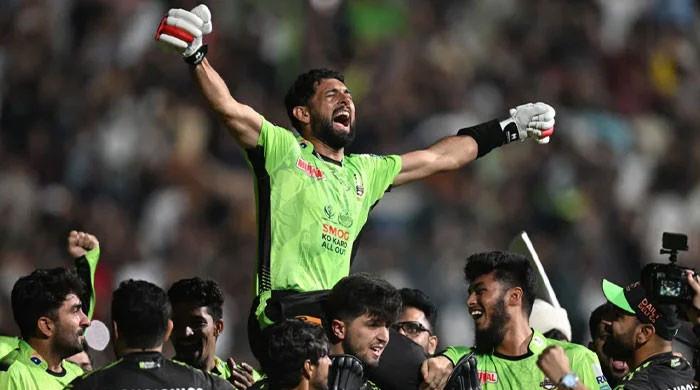
The Pakistan Cricket Board (PCB) on Thursday refuted news circulating in the media regarding the finalisation of the two city names for new Pakistan Super League (PSL) franchises.
In a statement, the PCB clarified that, as per the process, the successful bidders will have the right to choose a team name from any of the city/team names listed by the board earlier. Faisalabad, Rawalpindi, Hyderabad, Sialkot, Muzaffarabad, and Gilgit were the six teams shortlisted by the PCB.
“The PCB is pleased to note and welcomes the growing interest in acquisition of team franchise rights for two new teams for future editions of the PSL,” it added.
PSL Chief Executive Officer (CEO) Salman Naseer announced last month that an auction will take place for two new franchises in the 11th edition of the tournament.
“An auction will be held for two new PSL franchises. Bidding parties will be given a pool of city names from which they can select one team,” Naseer told reporters in a presser in Karachi on October 29.
It is pertinent to mention here that the public advertisement for tendering of the Team Franchise Rights was published on November 15, 2025 and invites bids from interested parties from around the world.
The deadline for submitting technical proposals is December 15 2025 at 11am, the PCB said.
Sports
‘The canaries in the coal mine’: Why teams like Man United invest in player care
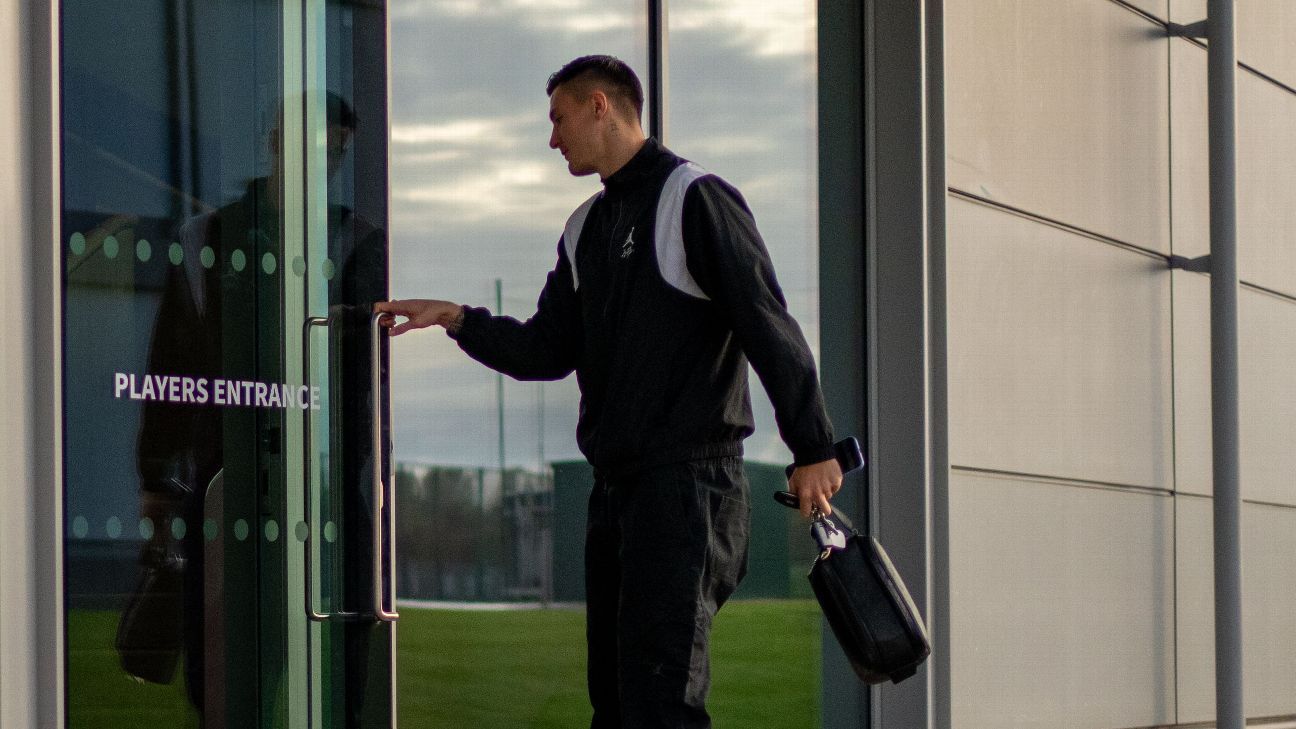
Each day, Manchester United‘s players drive down Birch Road, occasionally stopping for the horses from the Carrington Riding Centre or a cyclist, and turn into the club’s training ground. When the autograph seekers are satisfied and the entry barriers are lifted, they turn in front of the red neon “Manchester United” sign and head toward the first team parking lot behind the main building.
With their sports cars and luxury SUVs locked and their travel bags under their arms, they walk inside.
Once in the area known as the “players’ corridor,” an office behind glass panels is immediately on the left side, with a large desk in the middle and chairs on either side. On the back wall is a large flat-screen TV, and there are telephones and laptops in the room. The door is always open.
But it’s not an office for manager Ruben Amorim, CEO Omar Berrada or director of football Jason Wilcox. Instead, this room is reserved for the player care team. It’s the department that works to ensure each squad member has everything they need off the pitch so they can perform on it.
Player care departments aren’t unique to United. Across the Premier League, clubs are investing more to make sure their players have everything they need to perform at their optimum level. At United’s training ground, these services are front and centre for a reason.
The goal? Players leaving their problems at the door, feeling better and heading into training with a clear mind, ready to focus on football.
What is player care?
If the manager’s job is to oversee what happens at the training ground, it’s the responsibility of the player care department to look after the rest. Anything and everything a player might encounter can land on their desk, most of it not football-related.
“It’s based around the person rather than the player,” player care expert Hugo Scheckter told ESPN. “A very vague way of putting it is that it’s everything that affects a player that’s not football or medical. For three or four hours a day, players are at the training ground. Everything outside of that can be covered by player care.
“It could be personal-developmental stuff, giving them the life skills to improve themselves, welfare stuff like signposting to mental health provisions, or operational things like relocations and problem-solving. We’re trying to be that resource where they can remove the stress away from life to focus on football.”
– Ian Darke’s PL stars so far: Haaland, Caicedo, more
– If the World Cup started today, who will win it?
– Connelly: Lessons learned after 10 games in top leagues
Scheckter has worked for Premier League clubs, including West Ham and Brentford, and in 2020, he set up the Player Care Group. He has years of experience helping players find houses, pick schools for their children, tax cars and sort match tickets.
Other times, it means dealing with emergencies such as a car accident or home break-in. Occasionally, the problem is more unusual.
“I had one player who asked me to hunt a bird that was scaring his girlfriend. He wanted it shot, and I had to say, ‘We don’t do that in England,'” Scheckter said.
“My solution was to get an ultrasonic bird that basically scared it away, but his first thought was can we [kill it]? Ultimately, they wanted a problem solved, and I can understand that. The bird was tapping on the window all the time, and his girlfriend was scared of birds. So we got a little £10 thing on Amazon to scare it away.
“It can seem a small thing, but then on the other hand, if he’s awake all night or always getting complaints from his girlfriend, it can affect performance. It sounds silly, but it can be quite important as well.”
‘The canaries in the coal mine’
In the search for marginal gains and a competitive edge, clubs are increasingly taking player care more seriously. Foster and Partners, the London-based architectural firm responsible for the £50m revamp of Manchester United’s Carrington training ground, purposely put the player care office toward the front of the players’ entrance to the building.
It’s a similar story at clubs all over the world.
“The player care team are like the canaries in the coal mine,” one high-level source at a Premier League club told ESPN. “Often, they’re the ones who can spot the first sign of trouble.
“Coaches and medical staff will know everything about a player’s performance, but the player care or player support team know far more about their non-football lives than a manager or coach. And the two things are intertwined. One impacts the other.”
Scheckter adds: “I think it used to be a very reactive service where a player would bring a problem in, and they would try and solve it. Now, I think you’re seeing more and more clubs who are trying to get ahead of those problems, so they don’t even appear at all. Or if they do, that they’re well-managed, and there’s a process in place.”
Investment in player care varies from club to club. Player care teams can range from one or two employees to five or more. Most Premier League clubs have separate departments for their men’s, women’s and academy sides.
Most of the time, however, the department’s effectiveness depends on how seriously it’s taken by the first-team manager and his staff. Some coaches can be quite dismissive of anything that goes on outside the training ground, but others are keen to take a more holistic approach.
“A lot of time, it’s club culture-dependent,” Scheckter said. “I’ve had managers who are not negative towards it, but kind of apathetic. It depends from manager to manager. With some, you just stay out of the way, and with others, you’re really involved at the top table in management meetings every day. That’s really exciting as well.”
There are clear benefits to including the player care team in performance meetings that include other key heads of department.
“You’ve got the nutritionist there, you’ve got the fitness coaches there, you’ve got the coaching staff there, the manager there. And the conversation can be about a player who has lost three kilos in the last month,” Scheckter said.
“I can be like, ‘Oh well, that’s because his girlfriend is away and he doesn’t cook.’ So next time his girlfriend goes away, we need to make sure he’s getting food delivered or we get a chef in, or whatever it is. The nutritionist in isolation might be thinking he’s unwell or he’s skipping meals. It’s good to have that joined-up approach.
“I’ve gone to managers before and said privately, ‘Look, his mother died a year ago on this day, just so you are aware,’ and they’ll go, ‘OK, thank you. That’s why he was off today in training.'”
With football becoming an increasingly global game, there’s pressure on player care teams to help players new to the country settle quickly. It’s not unusual for departments to be in touch with counterparts at rival clubs, especially if they have players of the same nationality.
“If we’ve got a player from Brazil, we might get in touch with another club local to us if they also have a Brazilian player,” one Premier League source said. “It’s in our interest to do that, share intelligence, and help build a wider network for a player’s family to help them feel settled.”
1:12
Are Manchester United getting smarter with their transfer deals?
Mark Ogden explains why there’s optimism around Manchester United’s transfer strategy after turning down the chance to sign Chelsea’s Roméo Lavia.
In many circumstances, the role of the player care team extends beyond the players.
“The partners, especially at the Premier League level, none of them tend to work or very few of them tend to work, and so you have a situation where they’ve just sat around and so trying to provide a purpose for them and a direction for them is really important,” Scheckter said.
“We see it more and more where the player is really happy, but the partner or the family aren’t, and so we’re seeing clubs invest more and more into family programs.
“It can be hard moving to a new country. We’re definitely seeing that as a bigger issue, where players are happy, partners are not, and then that’s leading to a player either wanting to leave or talking about potentially having to leave, which is a disaster for clubs.”
Whether it’s to take on the role of wellness professional or concierge, the job of the player care team is to keep players happy. But that doesn’t mean clubs want to pamper their stars.
“There’s a balance,” one source told ESPN. “We don’t want players who are detached from everyday life. But we also don’t want players worrying about renewing a passport or a dispute with a landlord because that takes up mental space.
“There’s a growing understanding throughout sport that mental well-being is important to performance. We want to take away the burden of the stresses associated with everyday life as much as we can so players can focus on training and matches.”
‘Make sure the athletes are the best they can be’
More often than not, the player care team members work in the background. On other occasions, they’re thrust into the spotlight.
After West Ham failed to win for more than two months, new manager Nuno Espirito Santo revealed that the club’s player care department sourced baby pictures of the players to decorate the dressing room to serve as motivation ahead of Newcastle’s visit to the London Stadium. It worked, and West Ham won 3-1.
“It was a surprise for everybody,” Nuno said afterward. “The player care [team] really do things really nice. They did it in a really nice way, the player care. The players didn’t know.
“It’s nice to see when we are young and had dreams. For us, it is important to go back to that feeling of being young and happy and try to enjoy things.”
Scheckter tells a story about a player he encountered at the start of his career in player care who appeared to be fine on the surface but left at the end of the season because his partner hadn’t settled.
There also have been small wins that can make all the difference.
“There was a player who was consistently late for team meetings and he was an African player, and he got dropped from a game,” Scheckter said. “The manager was basically like, ‘He’s just not professional, he’s not focused.’ So, I went and spoke to him, and he was very upset about it.
“I said to him, ‘Why are you late? He said, ‘Well, where I’m from … we don’t have reliable transport, we don’t have reliable timekeeping devices, and meeting time in my culture and my life has always been a suggestion.’ And I’m like, ‘Well, OK, I appreciate that, but in the UK or in England, if you’re not five minutes early, you’re late.
“And so I said, ‘OK, let’s work with you.’ I would go and knock on his door or go get him before everything he had to be at for a couple of weeks, and after those couple of weeks, then he kind of got it and was on time. It’s about working proactively to solve problems and make sure the athletes are the best they can be.”
In the end, the goal is always the same, whether the issue is timekeeping, staying on top of the pressures of the game, or dealing with a bird that won’t stop tapping on a window.
-

 Tech5 days ago
Tech5 days agoNew carbon capture method uses water and pressure to remove CO₂ from emissions at half current costs
-

 Politics6 days ago
Politics6 days agoBritish-Pakistani honoured for transforming UK halal meat industry
-

 Sports5 days ago
Sports5 days agoTexas A&M officer scolds South Carolina wide receiver after touchdown; department speaks out
-

 Business5 days ago
Business5 days agoThese 9 Common Money Mistakes Are Eating Your Income
-

 Sports6 days ago
Sports6 days agoApple scrapping MLS Season Pass service in ’26
-

 Business6 days ago
Business6 days agoWhat’s behind Rachel Reeves’s hokey cokey on income tax rises?
-

 Tech6 days ago
Tech6 days ago$25 Off Exclusive Blue Apron Coupon for November 2025
-

 Fashion6 days ago
Fashion6 days agoAfter London, Leeds and Newcastle, next stop Glasgow for busy Omnes






